| کد مقاله | کد نشریه | سال انتشار | مقاله انگلیسی | نسخه تمام متن |
|---|---|---|---|---|
| 6367645 | 1316843 | 2013 | 10 صفحه PDF | دانلود رایگان |
- Sulfate-reducing columns treating mine drainage were subject to aerobic stress events.
- Columns were generally resilient to air exposure and sulfate reduction re-established.
- Columns biostimulated with ethanol achieved the highest post-perturbation sulfate-reduction rates.
- Aerobic stress had a stronger influence on the microbial community than biostimulation or bioaugmentation.
- Pre-exposure to oxygen may be a strategy for enhancing resilience.
Sulfate-reducing permeable reactive zones (SR-PRZs) are microbially-driven anaerobic systems designed for the removal of heavy metals and sulfate in mine drainage. Environmental perturbations, such as oxygen exposure, may adversely affect system stability and long-term performance. The objective of this study was to examine the effect of two successive aerobic stress events on the performance and microbial community composition of duplicate laboratory-scale lignocellulosic SR-PRZs operated using the following microbial community management strategies: biostimulation with ethanol or carboxymethylcellulose; bioaugmentation with sulfate-reducing or cellulose-degrading enrichments; inoculation with dairy manure only; and no inoculation. A functional gene-based approach employing terminal restriction fragment length polymorphism and quantitative polymerase chain reaction targeting genes of sulfate-reducing (dsrA), cellulose-degrading (cel5, cel48), fermentative (hydA), and methanogenic (mcrA) microbes was applied. In terms of performance (i.e., sulfate removal), biostimulation with ethanol was the only strategy that clearly had an effect (positive) following exposure to oxygen. In terms of microbial community composition, significant shifts were observed over the course of the experiment. Results suggest that exposure to oxygen more strongly influenced microbial community shifts than the different microbial community management strategies. Sensitivity to oxygen exposure varied among different populations and was particularly pronounced for fermentative bacteria. Although the community structure remained altered after exposure, system performance recovered, indicating that SR-PRZ microbial communities were functionally redundant. Results suggest that pre-exposure to oxygen might be a more effective strategy to improve the resilience of SR-PRZ microbial communities relative to bioaugmentation or biostimulation.
258
Journal: Water Research - Volume 47, Issue 14, 15 September 2013, Pages 5316-5325
